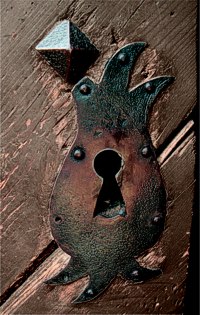Ľuba Paučulová
In past building culture smith and locksmith products have had always their own clear use connected to the sense of adequate aesthetic creation for each individual product. The creativity of traditional smiths has been transferred in every historic period of material culture development into a richness of shape, compositional as well as technical ideas. However, time is merciless. The previously wide range of types of traditional smith and locksmith products that serve their purpose in buildings are slowly diminishing. Has the friendship of architecture and both crafts remained in harmony up to now?
Outside of the cities, the folk architecture tradition of the inhabitants has almost completely ceased to exist. The magnificent buildings of folk architecture, modelled by hundreds of years of experience have mainly been replaced by several-story buildings lacking shape and with shameful aesthetics. The decomposition of the visual face of the Slovak countryside continues. The current building of family houses usually does not continue with a specific regional design; it is rather a mixture of shapes without an architectonic idea.
In the cities, the disharmony of design of a settlement (or part thereof) is even more underlined by the larger possibilities for builders and more significant desire to differentiate from others and from the environment. Greater possibilities do not always mean a good result for the smith craft. Apart from other things, a good result is given by the suitability of the use of the product on a house and in connection with others in the area. We often meet with the fact that smith product is in disharmony with the house, it is disproportionate, over complicated or there are too many products in one place. Sometimes it would even be better if it was not used at all because it does not fit into the environment. There is really only very little of “architecture of continuation, of context” in Slovakia based on municipal and city traditions of building, there is no stress on regional specifics and cultural identity in architecture, and we are often obsessed with modern and contrasting. To be interested in creating new architecture for municipal and city settlements of mountainous areas that would be tailored to the area of every region of Slovakia and would continue with the rich tradition or historic architecture, is unfortunately, not an attractive topic of our architecture. The importance of building detail is underestimated. The connection between the architect and craftsman is weak, and the task of the artistic craft in the concept of architectonic work is unappreciated. If we therefore are trying to look for sources of inspiration for seeking solutions, it would be good to start on a patient search in a source of historic architecture and traditional craft.
